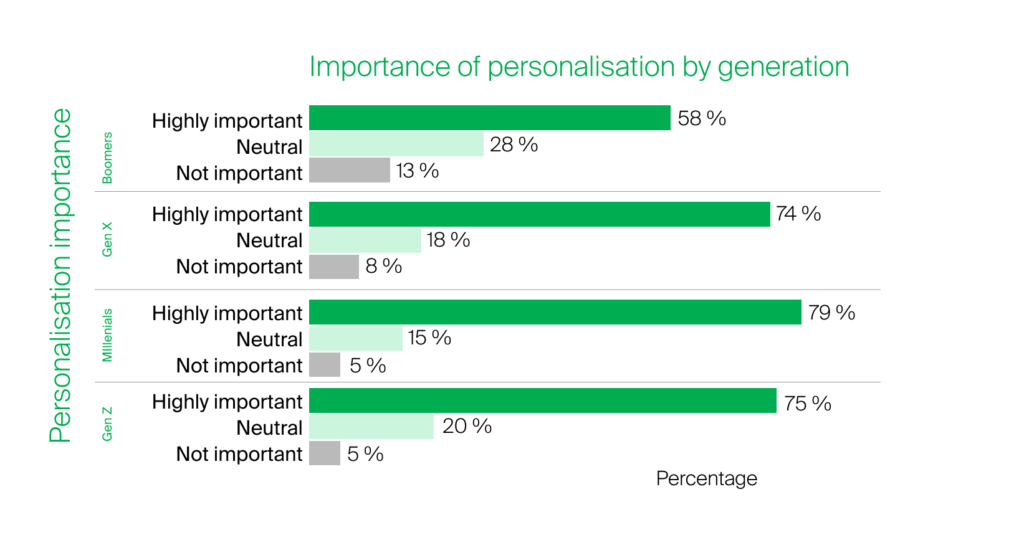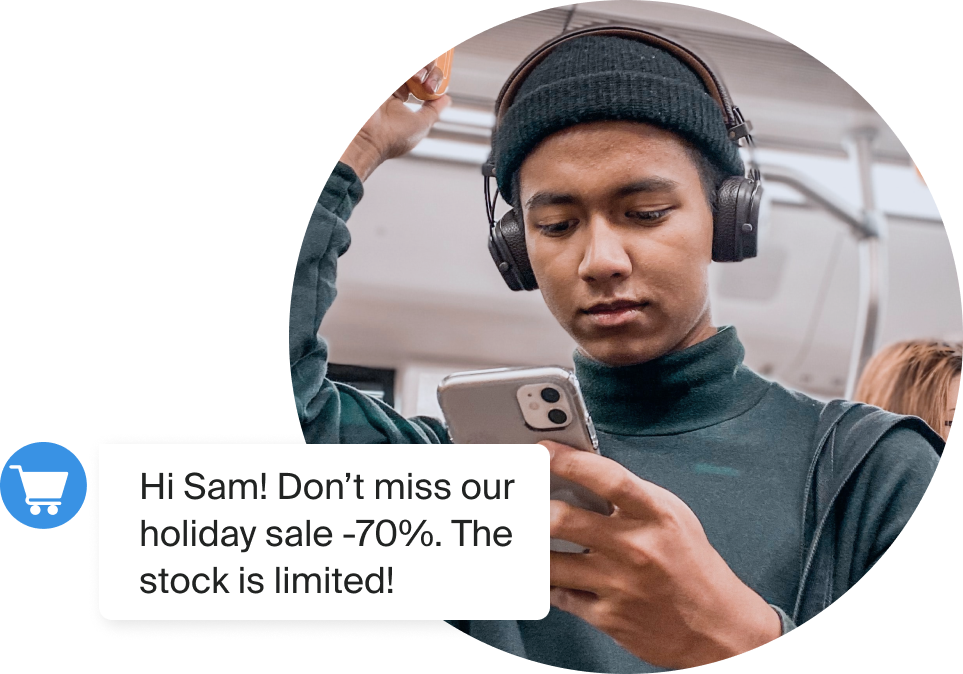Finance Comes Full Circle
For consumers of financial services, personalisation is the primary driver of enhanced experience. A survey report by Capco revealed that 70% of consumers across all demographic groups and income levels rated personalisation as highly important. So, financial institutions that aren’t harnessing their customer data to create hyper-personalised multichannel interactions are missing out on a critical competitive differentiator.
Establishing trust through personalised relationships has always been a fundamental aspect of the Financial Services Industry (FSI). In the past, customers would frequent physical branches, engaging in conversations with friendly bank tellers, and often be on first-name terms with their bank manager. Digital transformation started to trend in the 1990s and, coupled with the modern consumer preference for speed, efficiency and mobility, has shifted consumers’ interactions with their finance providers away from face-to-face interactions to online banking. These increasingly remote interactions, the pursuit of cost-cutting, and being slow to invest in cutting-edge customer experience (CX) technology mean many financial institutions are unable to fully understand how their customers engage with them to personalise their journeys. As a result, 73% of consumers feel the financial services industry isn’t sufficiently customer centric and want their financial institutions to offer more personalised services.

The Foundation of Customer Communication Personalisation
To gain a comprehensive understanding of customer interactions and deliver prescriptive personalisation, financial services marketers need to leverage personal data collected from both online and offline channels. The benefits of this approach include:
- Real-time insights facilitate a deeper understanding of purchase drivers, behaviours, and attitudes and enable unified, nuanced real-time personalisation.
- Using AI-driven automation such as AI chatbots, financial institutions can make informed decisions about how to reach out to customers based on their specific behaviours, enabling personalisation on a one-to-one basis.
- A seamless end-to-end experience can be created by collating and integrating customer and operational data across every touchpoint including branches, web and mobile apps, social media, business messaging channels and call centres.

To maximise personalisation, finance organisation marketers need to utilise the 24/7 communication channels consumers use, like WhatsApp, Viber, SMS, AI chatbots and native app push notifications. These channels can be integrated into CRMs and connected to one another, providing direct and timely access to customers with hyper-personalised promotional, transactional, and conversational messages. They also provide their own granular data insights which can be used to continuously monitor and improve marketing efforts, products and services.
Done well, personalisation empowers financial organisations to proactively deliver solutions to customers, even before they become aware of their own needs. The benefits of customer communication personalisation in finance include increased engagement and conversion rates, enhanced customer loyalty and retention, an elevated customer experience, consistent omnichannel communications, and a stronger return on marketing investments.
Finance Customer Segmentation
By segmenting customers into specific groups based on data analytics insights, businesses can create tailored promotional and conversational business messages with highly relevant finance products and services that address consumers’ individual needs and interests. Segmentation should be based on data from multiple sources including historical buying or browsing behaviour, real-time activity, or answers to Viber, WhatsApp and AI chatbot surveys and polls. This data will reveal critical personal details like a customers’ investment preferences, or their finance needs based on their stage of life, such as going to university or saving for retirement.
By gleaning a customer’s age, income, retirement goals, risk tolerance and time horizon, a financial organisation can send tailored messages providing insights into suitable retirement savings options. It can also provide tips for maximising retirement income such as investment and asset allocation strategies, as well as portfolio diversification techniques. These messages can include links to informative blogs and white papers on the bank’s website, a retirement calculator tool, and contact details for expert financial advisors.

For customers that don’t use a messaging app, the bank can send an SMS with a call to action to talk to its website’s AI chatbot, which can take the customer through a series of questions and service options for retirement and escalate the conversation to a live agent, if required.
Continuing the retirement example, to keep customers updated on their planning progress, the AI chatbot can invite them to download the bank’s native app. They can then receive mobile push notifications notifying them of their investment performance, account balances, and progress towards their financial goals. This proactive approach affirms the bank’s expertise and keeps customers informed and engaged, fostering trust and transparency.
Personalisation with Transactional Finance Data
Financial Services Institutions can deliver standout 1-2-1 personalised experiences using the wealth of transactional data they hold about every customer. This can be used to create highly tailored messages based on customer intent, account information, and current context, to drive new financial products and services discovery. Say the transactional data shows a customer has booked a holiday or purchased a car, a retail bank can use SMS, WhatsApp or Viber to communicate travel currency, travel insurance or car insurance offers. Similarly, a financial AI chatbot can take on the persona of a trusted financial advisor by recommending credit or savings products to balance out the expenditure.
End-to-end Sales Cycle Personalisation
First, marketers should identify which financial services customers are most likely to need at each of the 5 purchasing cycle stages and then segment customers by their place in the cycle as well as their account and transactional data. Continuity and demonstrating to consumers that their needs are understood are critical to a successful sales journey, so financial institutions should use URL parameters and campaign data to acknowledge the value proposition that converted the consumer at each stage. For example, if a customer was browsing credit card options then abandoned their search, perhaps to look at competitor products, a well-timed SMS or WhatsApp message with a personalised offer such as a low APR and a link to the finance website’s AI chatbot, can bring them back into the sales cycle and reduce churn.
Personalised Cross-selling and Upselling

Cross-selling is important in financial services as it doesn’t incur customer acquisition costs, and it promotes brand loyalty and revenue. Personalisation plays a crucial role. By tailoring their offerings to individual customer needs and preferences, financial organisations can identify and capitalise on opportunities to expand their product or service portfolio. When a customer applies for a personal loan, for home improvement purposes, the lender can cross-sell personalised mortgage refinancing options or home equity lines of credit, based on the customer’s financial situation, allowing them to leverage their home's equity for further financial needs.
Similarly, in wealth management, personalisation is essential for upselling. By understanding a client's risk tolerance, investment goals, and financial aspirations, wealth managers’ marketing teams can send promotional messages via Viber and WhatsApp, or program their AI chatbot to recommend higher-value investment opportunities, or additional wealth management services like estate planning or tax optimisation strategies.
Improving Customer Service with Personalisation
The financial services sector can program AI chatbots to deliver highly personalised, real-time customer support to address inquiries and challenges more accurately and efficiently.
A finance chatbot provides round-the-clock support, instant responses, and consistent service quality, while also using sentiment tracking and keyword association to identify when it’s necessary to escalate the conversation to a live customer service agent or finance expert. Customers can have their queries resolved quickly, obtain relevant information, and receive personalised guidance on financial matters. This leads to increased engagement and higher customer satisfaction, whilst boosting loyalty and increasing customer lifetime value (CLTV).
Interactive Financial Education
Finance organisations can leverage Viber's interactive features to provide personalised financial education. Marketers can create interactive quizzes or polls on topics like budgeting, saving, or investment strategies. Customers can engage with these messages by answering questions or participating in polls, receiving personalised feedback or recommendations based on their responses. This educates customers while also encouraging active participation and deeper engagement.
Conclusions
In the finance sector, personalisation is paramount for building trust, driving customer retention, and ultimately increasing revenue. By adopting customer communication personalisation best practices and leveraging the features offered by popular messaging channels like WhatsApp, Viber, AI chatbots, SMS, and push notifications, finance organisations can create tailored experiences that resonate with their customers' needs and preferences and build trust and loyalty.

